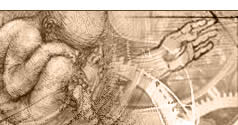 |
 |
 |
 |
 |
 |
 |
 |
|
 |
 |
 |
91 The degeneration of human language
|
| Menu | back |
Investigations of ancient languages show that they were more complex in earlier times and became simpler over time. The following holds for ancient Latin, Greek, Hebrew, Chinese, and Native American languages. For as far back as we can see, early human languages were able to communicate more information with fewer words than is the case with modern languages. Also, more precise formulations were possible with these languages. This contradicts the evolutionary idea of development from simple beginnings to greater complexity.
It has turned out that the idea of development of human language from primitive beginnings to a more sophisticated state is not upheld by the evidence. The languages of so-called aboriginal natives are not the least bit primitive. They are highly complex, in most cases much more complicated than our European languages.
Research into aboriginal languages has made it clear that there is no connection between the cultural level of a society and the structure of its language. This means a tribal society can live under the simplest conditions imaginable and still use an extremely complex language.
The complex structures of Old Sumerian, Old Akkadian and Old Egyptian contrast impressively with the, in some cases, comparatively very simple morphological structures of the modern languages spoken in Europe today. Whereas Akkadian, for instance, had thousands of synthetic verbal forms, modern German has a comparatively small inventory of forms (1). The term synthetic verbal forms designates linguistic forms comprising a single word and requiring no further auxiliary verbs (e.g., have, be, want to, may) to complete or complement their meaning.
Egyptian, Akkadian, Hebrew and Greek:
Roger Liebi carried out a study of very old languages of which we have written documentation covering long periods of history. The following were among the languages investigated: Egyptian (over 4,000 years), Akkadian (2,600 years), Hebrew (3,500 years) and Greek (3,500 years). Liebi concluded, Everywhere you look in the history of languages, the development you always see is characterized by degradation, reduction and simplification, i.e., in particular in morphology and the related field of phonology. The history of language can essentially be said to be characterized by devolution (backwards or downwards development) in the areas of morphology and phonology (2).
Liebi sees the reason for this in the laziness of speakers. This laziness results in the casting off of phonological elements to the point of elimination of morphological structures.
The Tower of Babel:
The biblical report tells us that all of the people living after the great flood spoke a single language. As they began to spread abroad, they said to one another, Come, let us build ourselves a city, and a tower with its top in the heavens, and let us make a name for ourselves, lest we be scattered abroad upon the face of the whole Earth. As a punishment for this hubris, God then confused their language and scattered them abroad from there over the face of all the Earth, no longer understanding one another (3).
An interesting aspect of this account is that all of the cultures that arose at that time all over the Earth carried out astronomical calculations and erected in some cases gigantic monuments. Each culture possessed part of the totality of human information. It can be assumed that human languages have been degenerating ever since.
It would appear to approach nearer to the actual situation to seek the origins of human language in a single, highly complex language (which may have been vastly superior to our modern languages) than to derive them from the sounds made by animals (4).
These 92 | Menu |
back
|
References:
|
| (1) |
Roger Liebi, The Mensch, ein sprechender Affe?, Schwengeler Verlag, 1991, page 48. |
| (2) |
Roger Liebi, page 52. |
| (3) |
The Bible, Genesis 11,19. |
| (4) |
Roger Liebi, Herkunft und Entwicklung der Sprachen, Hänssler, 2007, pages 272276. | |
| |
Comment this Site!
|
 |
 |
 |
 |
|

